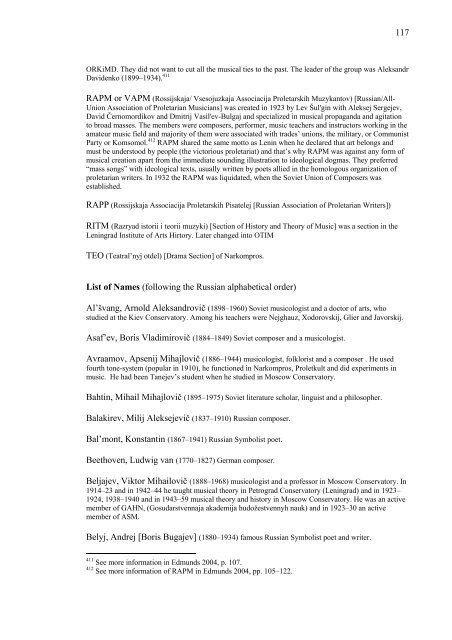Boris Asaf'ev and the Soviet Musicology - E-thesis
Boris Asaf'ev and the Soviet Musicology - E-thesis
Boris Asaf'ev and the Soviet Musicology - E-thesis
You also want an ePaper? Increase the reach of your titles
YUMPU automatically turns print PDFs into web optimized ePapers that Google loves.
ORKiMD. They did not want to cut all <strong>the</strong> musical ties to <strong>the</strong> past. The leader of <strong>the</strong> group was Aleks<strong>and</strong>r<br />
Davidenko (1899–1934). 411<br />
117<br />
RAPM or VAPM (Rossijskaja/ Vsesojuzkaja Associacija Proletarskih Muzykantov) [Russian/All-<br />
Union Association of Proletarian Musicians] was created in 1923 by Lev Šul'gin with Aleksej Sergejev,<br />
David Černomordikov <strong>and</strong> Dmitrij Vasil'ev-Bulgaj <strong>and</strong> specialized in musical propag<strong>and</strong>a <strong>and</strong> agitation<br />
to broad masses. The members were composers, performer, music teachers <strong>and</strong> instructors working in <strong>the</strong><br />
amateur music field <strong>and</strong> majority of <strong>the</strong>m were associated with trades’ unions, <strong>the</strong> military, or Communist<br />
Party or Komsomol. 412 RAPM shared <strong>the</strong> same motto as Lenin when he declared that art belongs <strong>and</strong><br />
must be understood by people (<strong>the</strong> victorious proletariat) <strong>and</strong> that’s why RAPM was against any form of<br />
musical creation apart from <strong>the</strong> immediate sounding illustration to ideological dogmas. They preferred<br />
“mass songs” with ideological texts, usually written by poets allied in <strong>the</strong> homologous organization of<br />
proletarian writers. In 1932 <strong>the</strong> RAPM was liquidated, when <strong>the</strong> <strong>Soviet</strong> Union of Composers was<br />
established.<br />
RAPP (Rossijskaja Associacija Proletarskih Pisatelej [Russian Association of Proletarian Writers])<br />
RITM (Razryad istorii i teorii muzyki) [Section of History <strong>and</strong> Theory of Music] was a section in <strong>the</strong><br />
Leningrad Institute of Arts Hirtory. Later changed into OTIM<br />
TEO (Teatral’nyj otdel) [Drama Section] of Narkompros.<br />
List of Names (following <strong>the</strong> Russian alphabetical order)<br />
Al’švang, Arnold Aleks<strong>and</strong>rovič (1898–1960) <strong>Soviet</strong> musicologist <strong>and</strong> a doctor of arts, who<br />
studied at <strong>the</strong> Kiev Conservatory. Among his teachers were Nejghauz, Xodorovskij, Glier <strong>and</strong> Javorskij.<br />
Asaf’ev, <strong>Boris</strong> Vladimirovič (1884–1849) <strong>Soviet</strong> composer <strong>and</strong> a musicologist.<br />
Avraamov, Apsenij Mihajlovič (1886–1944) musicologist, folklorist <strong>and</strong> a composer . He used<br />
fourth tone-system (popular in 1910), he functioned in Narkompros, Proletkult <strong>and</strong> did experiments in<br />
music. He had been Tanejev’s student when he studied in Moscow Conservatory.<br />
Bahtin, Mihail Mihajlovič (1895–1975) <strong>Soviet</strong> literature scholar, linguist <strong>and</strong> a philosopher.<br />
Balakirev, Milij Aleksejevič (1837–1910) Russian composer.<br />
Bal’mont, Konstantin (1867–1941) Russian Symbolist poet.<br />
Beethoven, Ludwig van (1770–1827) German composer.<br />
Beljajev, Viktor Mihailovič (1888–1968) musicologist <strong>and</strong> a professor in Moscow Conservatory. In<br />
1914–23 <strong>and</strong> in 1942–44 he taught musical <strong>the</strong>ory in Petrograd Conservatory (Leningrad) <strong>and</strong> in 1923–<br />
1924, 1938–1940 <strong>and</strong> in 1943–59 musical <strong>the</strong>ory <strong>and</strong> history in Moscow Conservatory. He was an active<br />
member of GAHN, (Gosudarstvennaja akademija hudožestvennyh nauk) <strong>and</strong> in 1923–30 an active<br />
member of ASM.<br />
Belyj, Andrej [<strong>Boris</strong> Bugajev] (1880–1934) famous Russian Symbolist poet <strong>and</strong> writer.<br />
411 See more information in Edmunds 2004, p. 107.<br />
412 See more information of RAPM in Edmunds 2004, pp. 105–122.

















